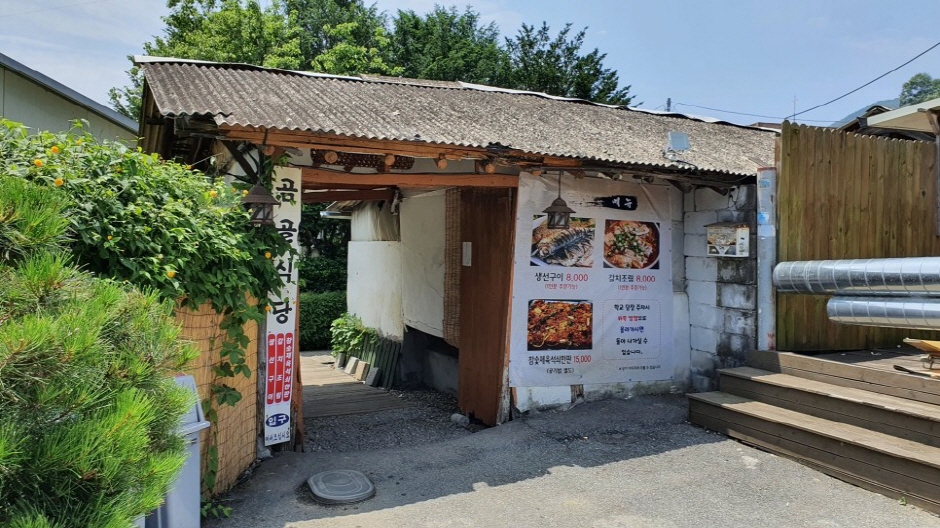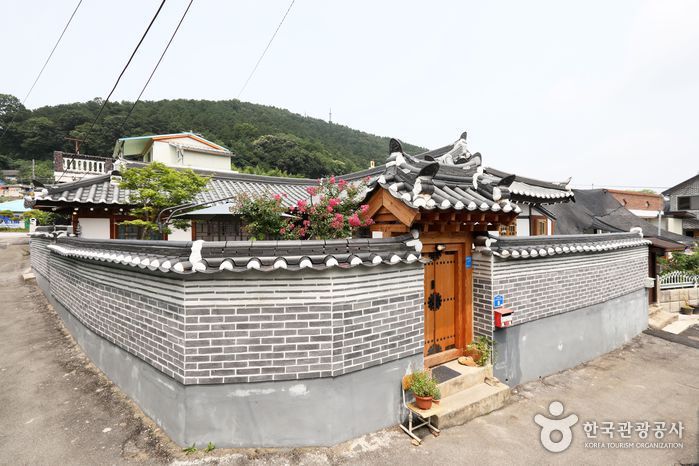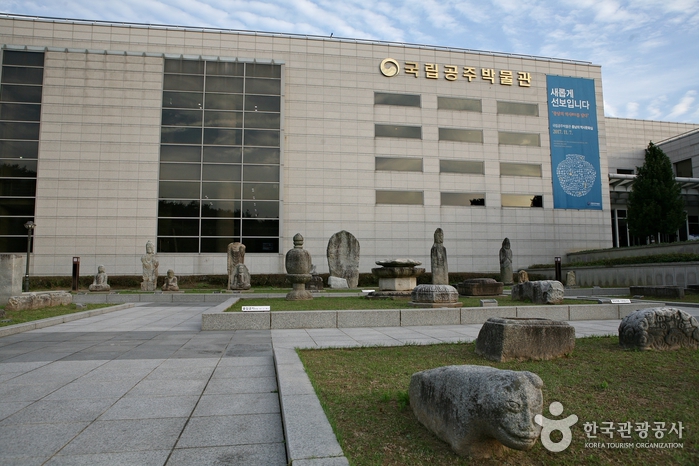Former Gongju-eup Office (옛 공주읍사무소)
13.4Km 2025-02-04
8 Ucheguk-gil, Gongju-si, Chungcheongnam-do
The Former Gongju-eup Office, a two-story Western-style red brick building built in 1923, stands as a symbol of Gongju’s modern history. Its interior showcases old photographs of Gongju, antique furniture, and a model of the current city. It also serves as a central venue for the annual Gongju Culture Night, held every fall, featuring performances, hands-on activities, and a flea market.
Lotte Himart - Daedeok Branch [Tax Refund Shop] (롯데하이마트 대덕점)
13.5Km 2024-04-22
14, Techno jungang-ro, Yuseong-gu, Daejeon
-
Lotte Mart - Noeun Branch [Tax Refund Shop] (롯데마트 노은점 [사후면세점])
13.5Km 2024-04-22
206, Bugyuseong-daero, Yuseong-gu, Daejeon
-
Restaurant Gomgol (곰골식당)
13.6Km 2024-01-09
1-2 Bonghwangsan 1-gil, Gongju-si, Chungcheongnam-do
This renowned restaurant in Gongju is always bustling. Upon passing through its old, time-honored main gate, one is greeted by a tastefully minimalist garden leading to the eatery itself. The restaurant boasts a carefully selected main menu, offering just three specialty dishes: charcoal-grilled spicy pork, grilled fish, and braised cutlassfish. Each meal is accompanied by an abundant array of ssam (wrap) vegetables and delicious side dishes, available for unlimited refills at the self-service bar. The charcoal-grilled spicy pork is expertly cooked for immediate enjoyment, without the need for diners to grill it themselves. The smoky aroma of the charcoal complements the subtle seasonings perfectly. The grilled fish offers a delightful contrast with its crispy skin and succulent flesh. An additional perk is the option to order single servings of all menu items.
Himart - Techno Valley Branch [Tax Refund Shop] (하이마트 테크노밸리점)
13.6Km 2024-04-18
31, Techno jungang-ro, Yuseong-gu, Daejeon
-
Indy (인디)
13.6Km 2024-03-20
202, 32 Techno jungang-ro, Yuseong-gu, Daejeon
Indy is an authentic Indian restaurant. The chef, with 15 years of experience in hotel kitchens, uses over 20 types of natural spices to flavor the dishes. Chicken makhni, known for its rich cream and butter taste, is the signature dish. Another popular item is the prawn chilli, featuring large shrimps in a spicy chili sauce. The warm nan bread and salads complement the curries perfectly. The restaurant also boasts stylish Indian-inspired decor.
Bonghwangjae Hanok Guesthouse (봉황재 한옥 게스트하우스)
13.7Km 2024-12-23
8 , Keunsaem 3-gil, Gongju-si, Chungcheongnam-do
+82-41-960-5525
Bonghwangjae is a hanok guesthouse is in Gongju, Chungcheongnam-do. It has four guestrooms, including a master bedroom with an attic that is mainly used by families. The other rooms are smaller in size, but one has a wooden veranda. Each room has a bathroom and toilet, and the big wooden-floored hall, the kitchen, and of course the yard are shared spaces. A simple free breakfast is provided. A walking tour round the old city of Gongju is offered by the owner - as is advice on where and how to take the best photos. The main tourist attractions of Gongju can all be reached on foot.
Gongju Tomb of King Muryeong and Royal Tombs [UNESCO World Heritage] (공주 송산리 고분군과 무령왕릉 [유네스코 세계문화유산])
13.7Km 2024-01-08
37-2 Wangreung-ro, Gongju-si, Chungcheongnam-do
The Songsan-ri Tombs and Royal Tomb of King Muryeong (r. 462-523) contain representative relics of the Baekje period (234-678). The Songsan-ri Tombs contain the graves of kings from the period when Baekje's capital was Gongju, and it is believed to contain 17 such graves. Only seven graves have been discovered so far. There are two types of tomb designs: traditional Baekje-style rock and earth fortification tomb and Chinese-influenced rock tomb. The tombs number one to five were made using the traditional Baekje-style design while tomb number six and the Royal Tomb of King Muryeong were made using the Chinese-influenced design. Even though many artifacts were stolen from the tombs, the tombs serve as an important evidence of Baekje culture and the foreign exchanges from during that period.
Doan-dong Gamnamujip (도안동 감나무집)
13.8Km 2024-03-28
54 Techno jungang-ro, Yuseong-gu, Daejeon
Doan-dong Gamnamujip, situated near Daedeok Techno Valley, stands out as a restaurant dedicated to duck dishes. Their diverse menu includes options like ori suyuk (boiled duck slices), nurungji baeksuk (whole chicken soup with scorched rice), and oritang (duck soup). Among these, the ori suyuk, celebrated for its tender texture and balanced fat content, holds particular popularity. Savoring it wrapped in lettuce with the accompanying seasoning sauce enhances the delightful experience.
Gongju National Museum (국립공주박물관)
13.9Km 2021-05-20
34, Gwangwangdanji-gil, Gongju-si, Chungcheongnam-do
+82-41-850-6300
Gongju National Museum preserves and displays cultural treasures, as well as provides educational programs for locals. The museum collection includes over 10,000 relics, including 19 National Treasures and three Treasures, all excavated from the Chungcheongnam-do & Daejeon areas. The most important of these artifacts are displayed permanently, while the remaining items rotate with special exhibitions. In front of the main building is a garden visitors can enjoy after touring the museum.
![Lotte Himart - Daedeok Branch [Tax Refund Shop] (롯데하이마트 대덕점)](http://tong.visitkorea.or.kr/cms/resource/28/2883528_image2_1.jpg)
![Lotte Mart - Noeun Branch [Tax Refund Shop] (롯데마트 노은점 [사후면세점])](http://tong.visitkorea.or.kr/cms/resource/31/2883531_image2_1.jpg)

![Himart - Techno Valley Branch [Tax Refund Shop] (하이마트 테크노밸리점)](http://tong.visitkorea.or.kr/cms/resource/25/2883525_image2_1.jpg)

![Gongju Tomb of King Muryeong and Royal Tombs [UNESCO World Heritage] (공주 송산리 고분군과 무령왕릉 [유네스코 세계문화유산])](http://tong.visitkorea.or.kr/cms/resource/95/2678695_image2_1.jpg)

 English
English
 한국어
한국어 日本語
日本語 中文(简体)
中文(简体) Deutsch
Deutsch Français
Français Español
Español Русский
Русский